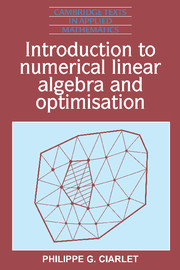Book contents
- Frontmatter
- Dedication
- Contents
- Preface
- I Numerical Linear Algebra
- 1 A Summary of Results on Matrices
- 2 General Results in the Numerical Analysis of Matrices
- 3 Sources of Problems in the Numerical Analysis of Matrices
- 4 Direct Methods for the Solution of Linear Systems
- 5 Iterative Methods for the Solution of Linear Systems
- 6 Methods for the Calculation of Eigenvalues and Eigenvectors
- II Optimisation
- Bibliography and comments
- Main notations used
- Index
3 - Sources of Problems in the Numerical Analysis of Matrices
from I - Numerical Linear Algebra
Published online by Cambridge University Press: 12 October 2018
- Frontmatter
- Dedication
- Contents
- Preface
- I Numerical Linear Algebra
- 1 A Summary of Results on Matrices
- 2 General Results in the Numerical Analysis of Matrices
- 3 Sources of Problems in the Numerical Analysis of Matrices
- 4 Direct Methods for the Solution of Linear Systems
- 5 Iterative Methods for the Solution of Linear Systems
- 6 Methods for the Calculation of Eigenvalues and Eigenvectors
- II Optimisation
- Bibliography and comments
- Main notations used
- Index
Summary
Introduction
While this chapter makes no attempt to be exhaustive, nevertheless an appreciable effort has been made to give an idea of the great variety of problems which eventually lead to the solution of one of the two fundamental problems of the Numerical Analysis of Matrices, and in particular those problems whose source lies in approximation of linear partial differential equations arising in Physics.
In this regard, it did not seem fruitless to make some brief observations on the physical aspects of the problems, on their mathematical analysis and, lastly, on their numerical analysis, especially whenever this last depends upon matrix analysis. Thus, in the case of one-dimensional boundary-value problems (introduced in section 3.1), we establish the convergence of the methods of approximation which are considered (cf. Theorems 3.1-2 and 3.4-3).
In sections 3.1, 3.2 and 3.3 some simple examples of boundary-value problems are considered (Poisson's equation, the heat equation and the wave equation). This gives rise to a description offinite-difference methods. Their use, in turn, involves the solution of linear systems with very ‘sparse’ matrices, whose zeros are arranged in a quite remarkable fashion, the matrices involved being examples of tridiagonal or block tridiagonal type. Related matrices which are, moreover, always symmetric are encountered in the variational approximation of these same problems (sections 3.4 and 3.5).
Problems involving the calculation of eigenvalues and eigenvectors of matrices are encountered in the approximation of the ‘stationary solutions’, or ‘waves’ of various physical systems. It is shown, in this respect, in section 3.6, that these problems very often make their appearance in the form of ‘generalised’ eigenvalue problems.
Other sources of linear systems are the problems of the interpolation of data by means of'piecewise polynomial’ functions, notably spline functions, as well as problems of least-squares approximation: these problems are encountered in section 3.7.
Finally, we mention some other examples, which get further treatment later in this work:
the solution of non-linear systems of equations, where the use of Newton's method leads to the solution of a sequence of'tangential’ systems of linear equations (section 7.5);
problems of the minimisation of a quadratic functional with linear constraints (section 7.2);
the implementation of Uzawa's method (section 9.4);
the implementation of the simplex method (section 10.3).
Information
- Type
- Chapter
- Information
- Introduction to Numerical Linear Algebra and Optimisation , pp. 64 - 123Publisher: Cambridge University PressPrint publication year: 1989
